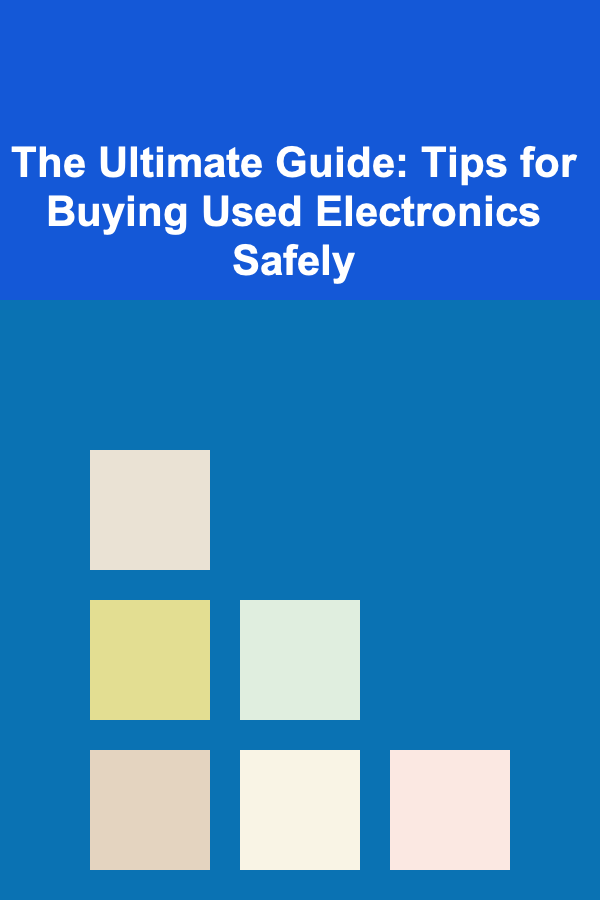
The Ultimate Guide: Tips for Buying Used Electronics Safely
ebook include PDF & Audio bundle (Micro Guide)
$12.99$10.99
Limited Time Offer! Order within the next:

Buying used electronics can be an excellent way to save money, especially when the items you're looking for are expensive new. Whether you're shopping for a smartphone, laptop, or home appliance, the appeal of purchasing a pre-owned item is undeniable. However, used electronics come with a unique set of risks, including the potential for faulty devices, hidden damage, or even fraud. To ensure you make a smart and safe purchase, it's important to follow a structured approach when buying used electronics.
This guide offers in-depth tips and actionable advice for purchasing used electronics safely, helping you get the best deal without the risk of getting scammed or ending up with a defective product.
Do Your Research Before You Buy
Before making any purchase, it's essential to do thorough research. Understanding the market value of the product you're looking for, knowing the common issues with specific models, and checking the device's typical lifespan can help you make informed decisions.
Key Points to Research:
- Brand Reputation and Product History: Research the brand and model to understand its reliability and common issues. For example, certain phone models may be prone to battery problems or screen defects. Look for online reviews and forums where other buyers share their experiences.
- Market Value: Make sure the price of the used item is reasonable. Used electronics should be priced lower than new models, but they shouldn't be so cheap that they raise red flags. Cross-check prices across different platforms and compare them to new versions to get a sense of a fair price.
- Warranty and Return Policy: Check whether the seller offers any kind of warranty or return policy, which can provide additional security if something goes wrong with the product after the sale.
Check the Seller's Reputation
The seller's reputation is one of the most critical factors when buying used electronics. Whether you're purchasing from an individual or a retailer, you want to ensure that they are trustworthy and that the transaction will be secure.
How to Verify the Seller:
- Online Marketplaces: If buying from online platforms like eBay, Amazon Marketplace, or Craigslist, review the seller's ratings, reviews, and history. Sellers with a high rating and positive feedback are typically reliable.
- Social Media and Forums: If you're purchasing through social media channels or a local classifieds group, look for reviews, comments, or ratings about the seller. Ask for recommendations from friends or acquaintances who may have dealt with the seller before.
- Local Retailers or Refurbishers: If buying from a local electronics retailer or a refurbished product store, check if they have a physical address and a customer service contact. Established businesses tend to offer better warranties and return policies.
- Ask for References: For private sellers, you can ask for references or previous buyer feedback. Many trustworthy sellers will be happy to provide this.
Inspect the Product Thoroughly
When buying used electronics, a detailed inspection is essential. This is particularly true for high-value items like laptops, smartphones, and gaming consoles. Even if you're purchasing from a well-known seller, a quick look at the product may reveal issues you weren't expecting.
Inspection Checklist:
- External Condition: Check for signs of physical damage such as cracks, scratches, or dents. While minor cosmetic imperfections may not affect functionality, significant damage can indicate that the item has been dropped or mishandled.
- Screen and Display: For electronics with screens (like smartphones, tablets, and laptops), inspect the display for dead pixels, discoloration, or cracks. These issues can affect your experience and may be expensive to repair.
- Buttons and Ports: Make sure all buttons, switches, and ports are working properly. For example, check that all USB ports, headphone jacks, and charging ports are intact and functional.
- Battery Life: One of the most critical aspects of used electronics, especially for mobile devices and laptops, is the battery. Ask about the battery's health (e.g., how many charging cycles it has gone through) and if possible, test its performance. Many sellers will allow you to use the device for a short time to check its performance.
- Accessories and Parts: Ensure that all necessary accessories (e.g., chargers, cables, or original packaging) are included and in good condition. Missing accessories can add extra costs, and incompatible cables or chargers may not work properly with the device.
If the seller is local, try to meet in person to inspect the item before buying. If you're purchasing online, request high-resolution pictures from different angles to get a clear view of the product's condition.
Verify the Product's Authenticity
The rise of counterfeit electronics has made it even more crucial to verify that the used item is genuine. This is especially true for high-demand items like smartphones, tablets, and smartwatches. Fake products often look similar to the original but can have serious performance issues and may not last as long.
Tips for Authenticity Verification:
- Serial Numbers and Model Numbers: Every genuine electronic product has a unique serial number. Verify this number with the manufacturer to ensure it's legitimate and hasn't been tampered with. Some brands (like Apple and Samsung) allow you to enter the serial number on their website to verify the device's authenticity and warranty status.
- Check for Brand Markings and Logos: Look closely at the device's logo, fonts, and overall design. Fake products often have slightly different logos or misspelled brand names. Authentic items usually have clear, consistent branding.
- Ask for Original Purchase Documentation: If buying from an individual seller, ask for proof of purchase or an original receipt. This can help confirm that the item was bought from an authorized seller and is not a counterfeit.
Test the Product Before Finalizing the Purchase
If possible, test the device before completing the transaction. Whether you're buying online or in person, make sure you can check the basic functionality of the device.
How to Test the Electronics:
- Power On the Device: Make sure it powers up and boots correctly. If it doesn't turn on or take too long to start, it could be a sign of an internal issue.
- Functionality Testing: For smartphones and tablets, test the touchscreen, camera, and other key features (like the microphone and speaker). For laptops, check the keyboard, trackpad, and any built-in features like webcams or fingerprint sensors.
- Check the Software: Ensure the device has the correct operating system and is free from malware or viruses. Some sellers may offer factory resets, but it's good to confirm the device is running a genuine version of the operating system.
- Test Connectivity: If the device has Wi-Fi or Bluetooth capabilities, test these features to ensure the device connects to networks or other devices properly.
Understand Return and Warranty Policies
One of the greatest risks of buying used electronics is the lack of recourse if the device stops working. To mitigate this risk, always confirm the seller's return policy and warranty before finalizing your purchase.
What to Look For:
- Return Policy: Sellers should provide a clear and fair return policy. Ideally, you should have at least a 14-day return window in case you discover defects or other issues after purchase.
- Manufacturer's Warranty: Some used electronics may still be covered by the manufacturer's warranty. Ask the seller for the device's warranty status and ensure you can transfer the warranty into your name.
- Seller Warranty: In addition to the manufacturer's warranty, some sellers may offer their own warranty on used electronics. This can provide extra protection in case something goes wrong after the purchase.
Be Aware of Scams
Unfortunately, the market for used electronics is rife with scams, especially when buying from individuals through platforms like Craigslist or Facebook Marketplace. Here are some common scams to watch out for:
- Too Good to Be True Deals: If the price seems unusually low, it may be a scam. Always verify the market value of the item and be cautious of deals that seem too good to pass up.
- Fake Payment Requests: Be wary of sellers who ask for unusual payment methods, such as wire transfers or gift cards. These are common red flags for fraud.
- No Return or Warranty: If the seller refuses to provide a return policy or warranty, it could be an indication that they are trying to sell a faulty product.
If something feels off or the seller seems evasive, trust your instincts and walk away from the deal.
Conclusion
Buying used electronics can be a rewarding and cost-effective choice, but it comes with its own set of risks. By doing your research, verifying the seller's reputation, inspecting the product carefully, and understanding the return policies, you can reduce your chances of buying a faulty or counterfeit device. Remember to prioritize safety, and never rush a purchase. With the right approach, you can find great deals on used electronics and enjoy the benefits of your new (but pre-owned) device without the worries of hidden issues.

How to Build Wealth with Passive Income Streams
Read More
How to Keep Your Garage Organized and Clutter-Free
Read More
How to Manage Money When You're Living Paycheck to Paycheck
Read More
How to Manage Pet Allergies While Keeping Your Home Pet-Friendly
Read More
How to Use Deep Learning to Develop High-Demand AI Products
Read More
The Public Relations Specialist's Playbook: Building Brand Reputation
Read MoreOther Products

How to Build Wealth with Passive Income Streams
Read More
How to Keep Your Garage Organized and Clutter-Free
Read More
How to Manage Money When You're Living Paycheck to Paycheck
Read More
How to Manage Pet Allergies While Keeping Your Home Pet-Friendly
Read More
How to Use Deep Learning to Develop High-Demand AI Products
Read More